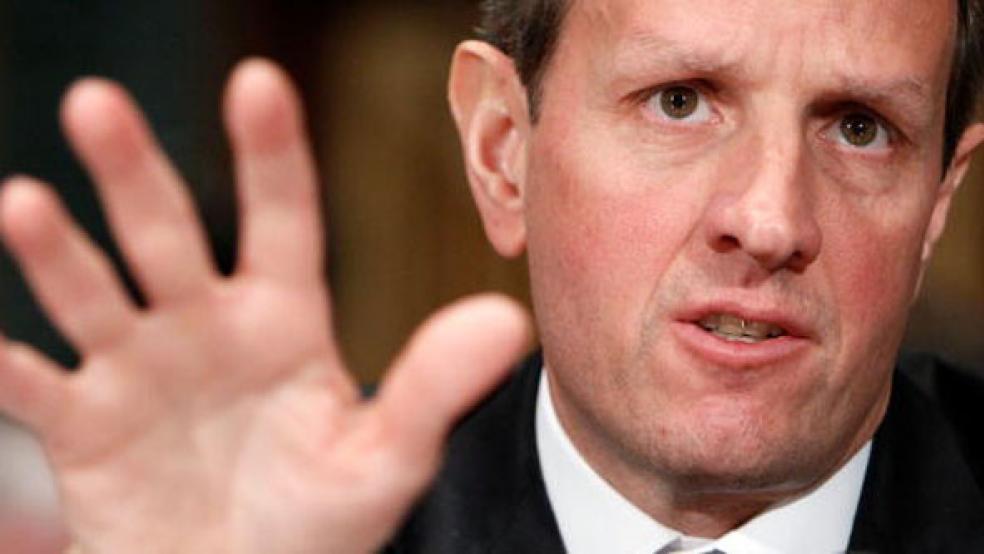The Treasury Department is crowing about a new analysis that claims the government’s massive bank bailout in response to the 2008 financial crisis will actually end up turning a profit of nearly $24 billion.
Treasury Secretary Timothy Geithner said that while the government’s overriding objective was to “break the back of the financial crisis and save American jobs,” it didn’t hurt that the TARP investments in U.S. banks “delivered a significant profit taxpayers.”
But whether the government’s Troubled Asset Relief Program will ultimately end up in the black or red is still an open question. And the Obama administration has been slammed by congressional Republicans and some financial experts for restoring Wall Street to profitability through TARP while millions of homeowners continue to struggle with foreclosures and more than 13 million people remain unemployed.
Outgoing Treasury Special Inspector General Neil Barofsky has said the administration mismanaged TARP and failed to accomplish some key goals; he pointed out that some of the largest banks that were deemed “too big to fail” are now 20 percent larger than before the crisis.
Critics say that the intervention will end up encouraging banks to grow much larger than is prudent and that this will ultimately benefit wealthy Wall Street investors rather than Main Street homeowners. In particular, the Home Affordable Modification Program has failed to make a significant dent in the number of mounting home foreclosures across the country.
"Claims of TARP's profitability are premature. The taxpayer will likely still take losses on TARP's housing programs," Sen. Richard Shelby, R-Ala., said at a recent hearing. "What matters most is TARP's negative long term impact on the overall economy, which will dwarf any profit generated, if there is any. On that basis, TARP's record has not been good for American families."
When Congress gave Treasury unprecedented power to intervene in the financial markets in October 2008, the legislative price tag was pegged at $700 billion, which was subsequently trimmed to $475 billion last summer as the bailout proved to be far less costly than expected. Now that the crisis has passed and the 2012 presidential election is looming, the administration appears eager to portray the effort as a successful and profitable government initiative, analysts noted.
"We still have more work to do repairing the damage caused by the crisis and strengthening the recovery, but today is an important milestone in our efforts to recover taxpayer dollars as we continue winding down TARP," Geithner said in a statement.
Even if Treasury does end up making a profit on the bailout, taxpayers probably could have received an even higher return if the risks of government asset purchases had been properly priced, said Chester S. Spatt, a finance professor at Carnegie Mellon University. "The Treasury wants to signal to the public: 'This was very successful, despite people's fears. We didn't lose money, we did the prudent thing and you can look at the outcome,’” Spatt said. "They are under some pressure from the House and the public."
According to the new analysis, the government will receive $23.6 billion in profits over the life of all the bailout programs, which breaks down into:
- $28.1 billion in losses from the bank, housing and auto investments that comprise the core TARP program, and AIG stock the government received.
- $13.5 billion in profits from Treasury purchases of mortgage-backed securities.
- $1.2 billion in profits from Treasury guarantees of money market funds.
- $110 billion in profits from Federal Reserve credit extensions and trading activity.
- $73 billion in losses from purchasing Fannie Mae and Freddie Mac preferred stock.
The Federal Deposit Insurance Corp. will break even on its bailout programs, because the agency can pass along any net costs to the banks through assessments. The estimate doesn't include the $787 billion stimulus package aimed at sparking economic recovery, Treasury acknowledged, while noting that cleaning up the savings and loan crisis cost a whopping 2.4 percent of gross domestic product.
"Jobs were lost, businesses failed, household wealth declined, and tax revenues fell," wrote Tim Massad, acting assistant secretary for financial stability, in a blog post. "But the damage would have been far worse without the government's emergency response. Moreover, the direct fiscal costs of the financial stability program are extremely low and almost without historical precedent."
Related Links:
Former TARP Official on TARP: A Big Fat Failure, Mostly (Time)
If TARP is So Profitable, Why Not Bail Out Everyone? (CNBC)





